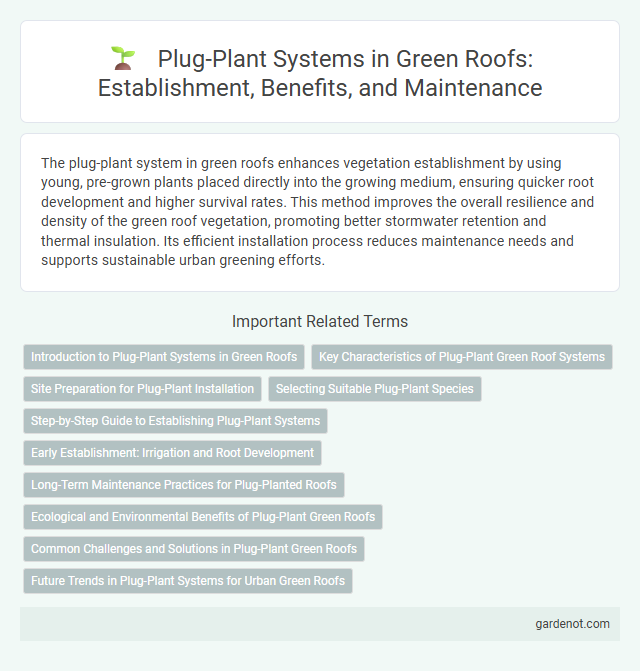The plug-plant system in green roofs enhances vegetation establishment by using young, pre-grown plants placed directly into the growing medium, ensuring quicker root development and higher survival rates. This method improves the overall resilience and density of the green roof vegetation, promoting better stormwater retention and thermal insulation. Its efficient installation process reduces maintenance needs and supports sustainable urban greening efforts.
Introduction to Plug-Plant Systems in Green Roofs
Plug-plant systems in green roofs involve the use of young, pre-grown plants cultivated in small containers or trays, allowing for efficient planting and establishment. These systems promote rapid vegetation coverage and root development, enhancing stormwater retention, thermal insulation, and biodiversity on urban rooftops. The method supports precise species placement and reduced soil erosion, optimizing green roof performance and longevity.
Key Characteristics of Plug-Plant Green Roof Systems
Plug-plant green roof systems feature pre-grown plants in small, individual containers that are spaced evenly across the roofing substrate. These systems enable rapid vegetation establishment, uniform plant distribution, and reduced maintenance compared to broadcast seeding methods. The key characteristics include high plant survival rates, ease of installation, and improved resistance to environmental stressors such as drought and wind.
Site Preparation for Plug-Plant Installation
Site preparation for plug-plant installation on green roofs involves thorough substrate assessment to ensure adequate drainage, nutrient availability, and pH balance tailored to plant species requirements. Proper substrate leveling and decompaction enhance root establishment, while removal of debris prevents obstruction to root growth. Pre-installation irrigation optimizes soil moisture, promoting immediate plug plant adaptation and minimizing transplant shock.
Selecting Suitable Plug-Plant Species
Selecting suitable plug-plant species for green roof systems requires prioritizing plants with proven tolerance to rooftop stressors such as drought, wind, and extreme temperatures. Succulents like Sedum, drought-resistant grasses, and native wildflowers offer robust root systems and low maintenance needs, enhancing green roof survival rates and biodiversity. Proper species selection based on local climate and substrate depth significantly increases green roof ecological performance and longevity.
Step-by-Step Guide to Establishing Plug-Plant Systems
Establishing a plug-plant system for green roofs begins by selecting appropriate drought-tolerant succulent species like Sedum and Sempervivum to enhance plant survival and growth. Prepare the growing medium by ensuring a lightweight, well-draining substrate composed of mineral components and organic matter to support root development and water retention. Install plugs at recommended spacing, typically 4 to 6 inches apart, watering regularly during the initial establishment phase to promote root establishment and minimize plant stress.
Early Establishment: Irrigation and Root Development
The plug-plant system enhances early establishment of green roofs by promoting efficient irrigation and accelerated root development. Controlled water delivery through drip irrigation ensures optimal moisture levels, encouraging healthy root growth and reducing transplant shock. This method supports rapid plant stabilization, improving green roof resilience and long-term performance.
Long-Term Maintenance Practices for Plug-Planted Roofs
Long-term maintenance practices for plug-planted green roofs include regular irrigation, precise weeding, and nutrient management to promote healthy plant establishment and growth. Employing periodic inspections helps identify pest infestations or drainage issues early, ensuring optimal plant vitality and roof performance. Applying slow-release fertilizers tailored to specific plant species enhances sustainability by reducing nutrient runoff and supporting diverse vegetation.
Ecological and Environmental Benefits of Plug-Plant Green Roofs
Plug-plant green roof systems enhance biodiversity by supporting native plant species, promoting habitats for pollinators and urban wildlife. These roofs improve air quality by filtering pollutants and mitigate stormwater runoff through increased water retention and evapotranspiration. The ecological benefits also include reducing urban heat island effects and contributing to carbon sequestration, making plug-plant green roofs a sustainable solution for urban environments.
Common Challenges and Solutions in Plug-Plant Green Roofs
Plug-plant green roofs often face challenges such as uneven root establishment, water stress, and nutrient deficiencies, which can hinder plant growth and overall roof performance. Solutions include selecting drought-tolerant species, optimizing irrigation systems, and using high-quality, nutrient-rich growing media to promote uniform root development and healthy vegetation cover. Regular monitoring and maintenance, including targeted fertilization and pest control, further improve the success rate of plug-planted green roofs.
Future Trends in Plug-Plant Systems for Urban Green Roofs
Emerging trends in plug-plant systems for urban green roofs emphasize automated planting technologies and precision horticulture to maximize vegetation density and biodiversity. Integration of IoT sensors enables real-time monitoring of microclimate and soil conditions, optimizing plant health and water usage. Advances in biodegradable plug materials and native species selection promote sustainability and resilience in increasingly urbanized environments.
Plug-plant system Infographic

 gardenot.com
gardenot.com